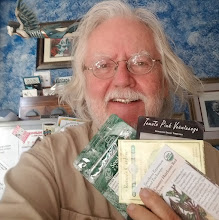
A community project, finished persimmon jam cools before being stocked. A friend with a fruit filled persimmon tree, desiring a willing accomplice, found me with my canning equipment and stove. We put up about 27 half pints of memorable eating. Persimmon jam has a taste that makes me think of mangoes with overtones of a kind of smokiness. It's a complicated, but mouth watering flavor.
Many Americans have no place to garden, they live in apartments and condominiums or the earth around their homes is just too shady. But wanting to grow vegetables and fruit for food or just wanting the pleasure of plunging their fingers in the cool moistness of the earth, a community garden might be their answer.
A community garden (defined as “a piece of land cultivated by members of a community, esp. in an urban area”) is usually a vacant lot or other unused land that some public body sets aside for people to grow some of their own vegetables (some gardeners do grow flowers, but the focus of most community gardens is primarily food). In some communities, Los Angeles among them, community gardens are sponsored by the city itself. Most of our community gardens are on LA Parks and Recreation land and are nominally under their control – although in practice, community gardens in LA have charters and are self-governed. In other communities (and some other in Los Angeles), community gardens are created by churches, schools, or other groups of people. The garden is laid out, plot sizes are agreed upon and a process to enlist gardeners promulgated. Plots in most gardens I have seen are between ten by ten to twenty by twenty feet. Some are smaller and some are larger (especially in communities where land is not as dear as it is in Los Angeles), but most gardens have plots about that size.
Those things are probably all decided long before the gardener comes on scene (for how to set up a community garden, see the American Community Gardening Association web site). What a gardener finds once assigned a plot is likely to be a new world completely populated by gardeners from many different cultures. This is, of course, less true in homogeneous communities, but in communities with any kind of diversity, the diverse populations of community gardens can be astounding. In my time at a nearby community garden, Ocean View Farms, I had neighbors from Mexico, Iran, France, other states, and England. All age groups were represented and all levels of gardening experience were present in all age groups. Among all these different people I learned gardening techniques and recipes for the use of the bounty of the garden from cultures the world over.
Almost thirty years later, I attribute my time at Ocean View Farms as pivotal in my gardening education. I learned more about gardening and what to do with the harvest that radically changed me – my experience before this had all been in the insular world of my childhood way back in Kansas. In the community garden, I learned to grow mint, artichokes, asparagus, paste tomatoes, yellow and purple beans, peppers and garlic – all food plants I had never seen in the soil because they were not in my family's pantry. I learned as well how to garden in a twelve month growing season.
The Los Angeles Times carried a story on community gardens on January 10th – as a board member of the American Community Gardening Association, I was able to offer some perspective on community gardens in Los Angeles. The Times article traces the progress of community gardens from the Victory Gardens of WW II – which, themselves were an outgrowth of the Liberty Gardens of WWI. History shows that whenever we are confronted with unprecedented disaster, we go back to the garden. Sometimes that disaster can be an internal emotional disaster. But returning to the garden has enabled more than one distraught person to feel as though they had taken their lives into their own hands. Truly it is meaningful to feel that you can feed yourself no matter what befalls the world or yourself. Many times, under duress and ready to give up, going to the garden has lifted my spirit enough to carry on.
If you have no place to grow your food, look into a local community garden. If you become a community gardener, consider joining the American Community Gardening Association and amalgamate your voice with theirs. With them and your community garden, you will learn to garden better, teach someone else to garden better and cultivate your own peace at the same time.
And you will have fresh tomatoes. Or 27 half-pints of persimmon jam that tastes like smokey mangoes. Life doesn't get any better.
david






.jpg)
No comments:
Post a Comment